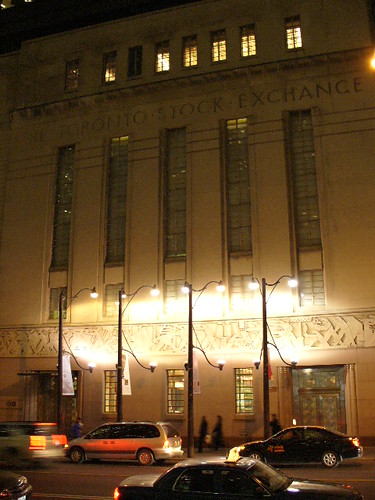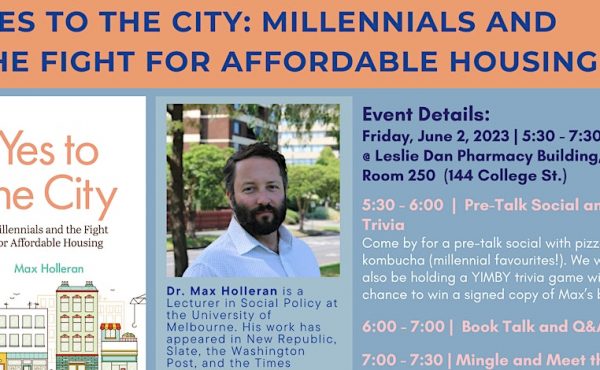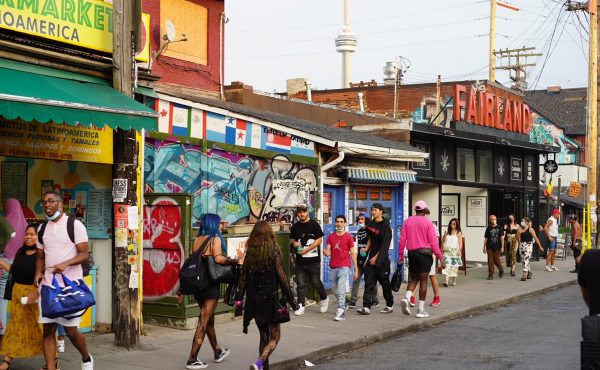
I just finished reading Ourtopias: Cities and the Role of Design, a collection of essays that were developed out of the Ourtopias conference hosted by the Design Exchange in June 2007. Through the various essays, the book surveys the role of design, past, present and future, in shaping the urban landscape. Though largely focused on Toronto and the GTA, several of the essays take their discussions beyond this city, looking more abstractly at what it means now, now and in the future, to live in increasingly global, urban areas.
I picked up my copy of Ourtopias at the official book launch and panel discussion on Wednesday night at the DX. The panel discussion was moderated by one of the book’s editors, Philip Beesley, Associate Professor at the University of Waterloo School of Architecture, and the panel was made up of Ian Chodikoff, editor of Canadian Architect, Chris Hardwicke, associate architect at Sweeny Stirling Finlayson & Co, Bruce Kuwabara, founding partner of KPMB Architects, and Charles Waldheim, Associate Dean, John H. Daniels Faculty of Architecture, Landscape, & Design at the University of Toronto.
I didn’t go to the event with the intentions of buying Ourtopias (it seems that there are so many books coming out right now about urban design, and design in Toronto, so buying every one of them would cost a fortune), but I decided to pick it up after listening to the hour-long panel discussion. With the exception of Charles Waldheim, all the panelists have essays in the book. During the discussion, the panelists presented a diverse set of opinions in response to provocations set out by Philip Beesley, and it was the rigor of their debates that convinced me to pick up the book.
In particular, I appreciated Kuwabara’s notion that the openness of Toronto’s city grid is a metaphor for our society’s openness to immigration. This openness generates its own beauty and complexity that, though easy to take for granted, makes Toronto, and its evolving urban form, unique. I also appreciated Chadikoff’s statement that the design community, through its educational institutions, should not polarize debates about the value of suburban versus urban contexts, or push one formal design approach over another, but instead should encourage designers (and design students) to engage meaningfully in the communities that they are designing for, allowing community participation to shape the final design product.
Although it was the above notions that prompted me to buy the book, as I was hoping that Kuwabara and Chadikoff would delve much further into these ideas in their essays; many of the other essays in Ourtopias are what really made the book enjoyable to me personally. Ourtopias is divided into three sections, Toronto, Possibilities, and Action. Both Kuwabara and Chadikoff’s essays are in the Toronto section (which deals mostly with the city and surrounding region as it stands now). The next section, Possibilities, contains an abstract series of essays that deal with the city and the potential of design, and the last section, Action, contains one essay about how to better integrate design into our culture (and why this is a good thing).
I really liked the Possibilities section. Regardless of whether or not I agreed with the authors in this section, their essays provocatively sparked my imagination. I particularly enjoyed reading Chris Hardwicke’s Ravine City and Farm City, which optimistically suggests ways of better integrating the built form with our surrounding natural landscapes (the landscapes that are still existing but in poor use, and those that are lost but could be reclaimed). Here is a quote:
“Farm City proposes a new kind of architecture that would enable cities to feed themselves by creating agricultural areas inside new housing towers. By combining living and growing spaces in a dense vertical format, Farm City reduces the need for sprawl in the suburbs, eliminates food travel distance, and creates a living architecture that is part of an urban ecosystem. Farm City allows urban dwellers to be responsible for the production of their food: to be farmers or gardeners. Farm City is a place where we can watch our food grow and take delight in our sustenance.”
Ourtopias was published by the Riverside Architectural Press in partnership with the Canadian Design Research Network and the Design Exchange.
Photo by wyliepoon




3 comments
In a rational univere, a blog like this one would *warn us in advance* of such an event.
Sounds like an interesting book I’d like to pick up. You mention there are other urban design books you like as well – do you mind posting some of the titles you recommend?
I’ve always advocated that cities should provide more spaces for plants, etc…
If the need for increased intensification around transit hubs is on the rise, then plans should also be made to allow for green spaces, whether it be on top of the new buildings themselves, or putting indoor parks and grow space inside them.
I also feel that at the same time, a new sort of P.A.T.H. should also be created, connecting all of these new buildings and grow spaces.